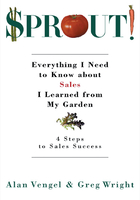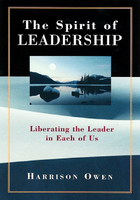Establishing a clear and profitable vision
THE CREATIVE CHALLENGE:
Using your vision to solve problems and develop new strategies for increasing sales
Seventh Generation, maker of nontoxic and environmentally safe household products, was faced with a dilemma regarding its values versus its sales when a large grocery chain that carried the company's products experienced a labor strike. As a company that strives to be a positive force in society, Seventh Generation had to decide whether to sell to the grocer since the strike involved health benefits. The company chose to continue to do business with the grocery chain during the strike but to donate all profits from those sales to the workers' strike fund. This action helped Seventh Generation maintain a good relationship with the grocer's employees, its customers, and the grocer itself, all of which contributed to future sales.
Vision. It's a simple word with huge connotations in the business world. Surely for anyone who has awakened in the middle of the night with a new business idea glowing like a 100-watt bulb in her head, the vision is sparkling clear, illuminating every fiber in her body. Most of us have had such "visionary" moments in our lives. Maybe it wasn't a new business idea but a new way to solve a problem or enhance your life or someone else's: an abrupt awareness of that nagging reason you couldn't balance the checkbook, a sudden insight into why your teenager has been giving you nasty glares for three days, the perfect way to celebrate your parents' wedding anniversary.
There's no discounting such moments of blinding insight when it comes to proposing a new idea. And of course, there's also plenty of room for those who start with a kernel of an idea, work laboriously and painstakingly to nurture it, and allow it to germinate fully before putting it into action. However it is reached and ultimately presented, a vision can be a critical component of creating sales and distribution strategies that move a business forward. In fact, it is often the foundation for many other aspects of a business that can play a role in promoting healthy sales and distribution: marketing, customer service, personnel issues, community outreach, public relations.
In a values-driven business, or socially responsible business, the vision is the torchbearer that leads his or her team proudly over the challenging terrain of business ups and downs. Occasionally this vision may alter its route, adjust for changes in the environment or climate, or even reconfigure the long-term strategy, but it will always maintain a steady course toward the goal at hand. Vision is looking to the horizon and imagining what could be. Vision is daring to head toward that horizon with a true sense of purpose and a plan of action.
In this chapter we will give you examples of business leaders who have established clear and profitable visions as they formulated their companies and then used their visions as strategic allies in selling their products or services. These visions encompassed a socially responsible agenda but were also modeled on sound business principles that took into account a very basic rule of success: people must want what you are selling, the product or service must be of high quality, and consumers must want to purchase it again and again.
Whatever business you're in—or hoping to create—you will be selling. In addition to your product, you will sell your concept to potential investors, you will sell your socially responsible mission, you will sell your brand and what it stands for, and you will sell what you stand for as an individual.
Although this book is about creative sales and distribution strategies, you won't be able to sell effectively unless your business is grounded in a powerful vision. A clear vision will drive you forward and enable you to scale new heights. It can get you through the tough times (and all businesses have them!) and help you adjust when change is required. Lack of vision will stifle you or send you in confusing directions. And if you don't know where you're headed, your investors, your suppliers, your community, and certainly your customers will be confused and may lose confidence in your business and your product. As Angela's writer and attorney friend Danny Quintana says, "It's easy to get where you're going if you know where you're going." [1] Your vision can be that shining, guiding star.
By establishing your vision and the actions that will support it, you will be better able to design and support strong sales and distribution strategies. First, let's take a look at a few socially responsible companies and the particular vision and actual business of each.
Seventh Generation makes nontoxic and environmentally safe household products. It wants to market products that save natural resources, keep toxic chemicals out of the environment, and make the world a safer place—for generations to come. The vision is to make the world a safer, healthier place and foster social and environmental change. The business is household products.
New Leaf Paper sells recycled paper. The vision is to inspire a fundamental shift toward environmental responsibility in the paper industry. The business is selling high-quality paper made from recycled content that can replace traditional "new" paper.
Hot Lips Pizza wants to be a positive influence in the community. The vision is to find new, sustainable ways of doing business as the company supports local growers. The business is selling pizza and homemade soda.
Tom's of Maine, the market leader in health and specialty products, has maintained a vision to do what is right for its customers, employees, communities, and environment. The business is creating and selling safe, effective products sourced in nature.
If you're just starting down the road of creating a values-driven business, you may occasionally run into challenges as you attempt to manage the social responsibility aspect of your venture with good business practices that boost sales. You may sometimes find it tough to keep your values aligned with day-today operations, especially if you're trying to change how people view your product or industry and possibly change their way of doing business.
Here we offer some Vision Strategies to help align your vision with sound business principles that will keep you headed toward increased sales.
VISION STRATEGY NUMBER ONE:
Think about how your vision and product combined can improve your customers' business or personal lives.
Keeping a compelling story and a compelling vision in the forefront of your sales efforts can play an important role in moving your business forward. You can use this strategy to relay the message about why your product is worth purchasing and help motivate your sales force.
As you are presenting your product (or service) to customers, it's important that your message be easy to understand. If you clutter your sales pitch with a complex explanation that weaves the details of your socially responsible mission with the benefits of your product, you may confuse the buyer to the point that it's just too much trouble for him to invest in what you're selling.
Another critical component of selling is listening. If you don't know your customer and what he needs or wants, your presentation may fall on deaf ears. Understand what you are selling and to whom you are selling it. Does your presentation need to be tailored for each customer? In other words, is Customer A likely to be more interested in the socially responsible benefits your product or business offers, and is Customer B going to be more interested in the actual product benefits? Consider how you can streamline your message so it is to the point and clear to those listening.
Here are some pointers from Jeff Mendelsohn, founder of New Leaf Paper.
Making It Compelling
Founded in 1998, New Leaf Paper of San Francisco, California, has grown rapidly the past few years and now does close to $20 million in annual sales. Similar companies were created in the early nineties but have since closed their doors or now operate as small regional companies. So why did New Leaf succeed when the others did not? "I think what we did well was to break into a high commodity business with a proposition that didn't scare people away," says Jeff. "We were able to address their business needs."[2]
One way Jeff and his staff have done this is by putting themselves in the shoes of their customers. "Take off your save-the-world hat," Jeff continues, "and put on the hat of whoever you're selling to, and think about what is going to be compelling to them." Of course, New Leaf has an environmental agenda, but approaching prospective customers with only this part of the mission would not make good business sense, according to Jeff. "People have a hard time selling on more than one platform. They get caught up in the environment and then that's all they'll talk about… we've always combined the environment with good business… they come out in the same breath. That's probably one of the reasons why we've been able to be successful."[3]
Key to New Leaf's selling approach is keeping the combined environmental and business message extremely clean and simple. In addition, Jeff stresses the importance of taking a partnership approach to business and emphasizing win-win deals with customers. "Listen to them very carefully," he says, "because, especially at the outset, your preconceived notions about what is going to sell and what is exciting to your customers will be partly right and partly wrong."[4] By listening to your customers, you make them feel appreciated. They also have a chance to be part of your mission if you embrace them in what you're doing.
Combining the company's vision with good business practices and finding a compelling story for each customer enables New Leaf Paper to lead the industry in the development and distribution of environmentally superior printing and office pa-pers.[5] Clearly, New Leaf Paper has found tremendous benefit in adding "compelling" to its business plan as it keeps its values-driven mission and product sales goals aligned.
VISION STRATEGY NUMBER TWO:
Align your vision with your community's interests.
If your business is small, the community in which you operate is probably very important to you. It may be the source of your employees, your customers, and even your suppliers. Therefore, your actions as a businessperson must be in tune with the needs and interests of your community because it includes the people who are supporting you. This strategy can be critical if you face a business challenge or want to sell a product or offer a service that is unfamiliar to your customers. In other words, the more trust and loyalty you develop among those in your community, the better chance you have of maintaining sales, keeping supplies on hand, and meeting shipping deadlines when challenges erupt. Developing strong relationships with those in your community is also important. Listen to their ideas and keep an open dialogue going so you can prevent small issues from turning into large problems.
"Community" is the key word in the next example. And it became key when the entrepreneurs took stock of their business and how they could build a company that matched their personal interest of supporting their community—something they determined was important to them as they were taking over the reins of the family operation and were preparing to "restart" the business.
The players in this story encompass the entire community, which is exactly what the business owners want. The story includes local farmers who wanted to find a new market for a specific product, as well as other local growers who supply the business with organic fruits, vegetables, cheeses, and meats. It also involves vision and putting business practices into place today so the business will be one step ahead of larger, more established competitors tomorrow. Remember that your secret weapon for gaining sales in your community may be ingenuity since you probably won't have the advertising dollars or brand awareness of bigger competitors (such as national chains).
Keeping the community's interests in mind helped these entrepreneurs rebuild the business. Their actions help maintain customer loyalty and help the company reduce costs (which helps boost profits) by using local, fresh ingredients that don't have to be imported. Fresh ingredients also make a higher-quality product, which again can help retain and increase sales.
Serve Your Business by Serving Your Community
Hot Lips Pizza owners David Yudkin and his wife, Jeana Edelman, took over her family's struggling Portland, Oregon, business, which began as a gourmet pizza company in 1984. The enterprise lacked an infrastructure, and it grew too fast. David and Jeana managed to pay off the sizable debt that had accrued and then took stock of the business and asked themselves why they were doing it and what they wanted from it.
One of the priorities for the couple was to be a positive influence on their community. About that time, David attended a presentation by Natural Step (an international organization created to accelerate global sustainability) and was influenced by Natural Step's advocacy of businesses' having a role in addressing the environmental issues of the time.
David also wanted to create a better place for his children, just as his parents and immigrant grandparents had done for him. And finally, he knew supporting his community, specifically by purchasing his ingredients from local farmers, was parallel with having a quality product. From all of this, David determined that the business's competitive edge was innovation, and innovation has been key to everything David has been doing since. His out-of-the-box thinking has garnered Hot Lips publicity on HBO and in the Wall Street Journal, Forbes magazine, and other publications, and it resulted in the small pizza chain receiving Portland's Businesses for an Environmentally Sustainable Tomorrow BEST Business Award in 2002.[6]">
As David was recreating his business, a billboard promoting a major pizza chain's use of sun-dried tomatoes made him realize he had to find a creative way to offer his customers a great product. He believes an innovative approach to doing business and building sales has to be tied to real issues that are part of the community.
To help the company put its new business model into place, David adopted Natural Step's concept of looking upstream—envisioning where you'd want to be if the world were sustainable. It's called "backcasting," according to David, and it helped him get a vision of his ultimate goals for Hot Lips and understand the steps he had to take to align his company with the future.
Serving the community by buying from the community is important to David and Jeana. Most of the ingredients for their pizzas and locally bottled soda are supplied by local farmers, and many are certified organic. "That's a goal of everything we do," says David.[7] In other words, his ingredients and supplies come from local businesses, so his purchases provide direct benefit to the community.
David is also big on finding solutions to local problems. An example is the way he helped local soft wheat farmers find a market for their wheat, which is used in bread products like his pizza. Because the northwestern area grows and mills mostly hard wheat, the soft wheat farmers had to create a new infrastructure for producing their product. According to David, the time and expense involved in recreating an infrastructure like this is one reason organic and local foods are more expensive.[8]
David used his vision of being a positive influence in his community to solve both a commodity problem and a distribution problem faced by local suppliers. His efforts also gave him a new source for an ingredient he needed to make a quality product and continue to foster goodwill within the community. Actions like this help Hot Lips build a more loyal customer base and greater sales.
VISION STRATEGY NUMBER THREE:
Be open to adjusting your vision as your business grows.
As your company grows, you need to review your objectives and listen to the marketplace, your customers, your suppliers, your employees, and your community to realign your values in a holistic, beneficial manner. For many businesses, this means forming deep relationships with everyone connected to the business and working together to make something larger and more important happen.
When it comes to sales, what you're selling and where it came from is only half the equation. You must also consider how your products are sold and to whom they are sold. When faced with a challenge regarding your sales efforts, creative thinking may go a long way in making the most of a difficult situation. Consider how you can create a win-win-win situation so you, your distributor, and your customers each have a positive outcome.
When Seventh Generation faced the challenge with the grocery chain that we highlighted at the start of this chapter, it was able to engineer a solution that benefited everyone. Although the company gave its profits to the workers on strike and therefore didn't make money on those sales, the goodwill and integrity the company created went a long way toward establishing Seventh Generation as a good company to do business with. Its actions demonstrate how the company makes its values—which go hand in hand with its vision—an essential part of its entire chain of relationships. Its relationship with the retailer continued, customers were still able to buy the company's products, and Seventh Generation was able to show solidarity with the workers on an important issue.[9]
Remember also that your product's value involves more than just its price. If your product resonates with customers on a level that goes beyond a simple exchange of money for an item that serves a purpose, you build brand loyalty that can translate into sales even when a competitor offers a better price.
Next we present more about how Seventh Generation has allowed its vision to evolve to the benefit of growing sales.
Evolution of Your Vision Builds Profits
Jeff Hollender, founder and CEO of Vermont-based Seventh Generation, believes a company's vision evolves over time. But before you can have a vision, you must know who you are and determine your own essence. From the beginning, Jeff focused on offering people avenues that helped them express their idealism, passion, and commitment to a cause larger than themselves and larger than the company. His definition of "people" included managers and employees as well as Seventh Generation's customers, suppliers, partners, and anyone else involved in the company's value and supply chain. "We've tried to be, in the largest sense, a satisfying company to work for and do business with, and a major part of that effort is having a well-developed vision of what it means to be a responsible business and a good corporate citizen," says Jeff.[10]
When Seventh Generation began in 1988, its product tag-line was "Products for a Healthy Planet." But over time, company officials saw a larger interest in health and wellness. In 2000, the wellness trend started to propel the natural food industry and began to have a very positive impact on Seventh Generation's sales.
Jeff is a firm believer in the idea that when people purchase a product, more than price comes into play. "At the end of the day," he says, "the question is, What is the perceived value of what you buy?" To him, value is a combination of price, product quality, and other benefits someone receives when purchasing a product, which may play a role in encouraging people to support a company that has values similar to theirs.[11]
A product with a tangible benefit could be one that has a direct impact on a person's health—such as a laundry detergent that makes the rash on a child's face disappear. Such a benefit, Jeff points out, is a powerful motivator when it comes to making a purchasing decision. Jeff believes that the health benefits his products offer have become an important driver for the company, even more so than the environmental benefits and the value of being a responsible business.
In addition to focusing on health and wellness issues and how the company's products impact the customers' lives, Jeff feels the idea of sustainability has expanded. "As you say 'sus-tainability,' you're no longer talking just about the environment, but you're talking about issues of equity and issues of justice because you can't have sustainability without equity and justice," he adds. This notion has made Seventh Generation increase its focus on the role that business needs to play in the world.[12]
With over eighteen years of experience, Seventh Generation has been "around the block" when it comes to creating a formula for sales success while remaining true to its values-driven mission. As one who started his company as a private venture, took it public, and then turned it back into a private company, Jeff also has a firm grasp on the importance of seeking investors who embrace his vision. Because he has chosen investors who share Seventh Generation's values (coupled with the financial success of the company), he's had no trouble obtaining additional investments from current shareholders.
By expanding its vision in these ways—moving from a primary focus on the environment to a focus on health, broadening the definition of "sustainability," increasing its focus on the role it needs to play in the world, and ensuring that its vision is aligned with its investors'—Seventh Generation has experienced 30 to 40 percent growth every year since about 2000, reports Jeff.[13] That is a very significant way to demonstrate the importance of allowing your vision to evolve over time.
■
For companies that have been in business for some time and perhaps have not always had a socially responsible agenda, incorporating values into the business and sales model may offer a unique set of challenges. Unlike a new business that can use its values-driven policies to set sales and distribution strategies right from the start, an established business must find innovative ways to demonstrate its new message and more responsible way of selling products.
Successful companies can and indeed do change how they operate when they adopt a more values-driven focus. We sincerely hope that as issues pertaining to the welfare of our planet and its inhabitants begin to resonate around the world, more and more companies will take steps to make some aspect of the term "socially responsible" part of their mission statement.
But you can't expect changes to occur overnight. You may add new customers, new suppliers, and new distributors as you go about transforming your business into a more socially responsible venture that you believe will boost sales or expand the business in new directions. However, you will likely retain your current customers, suppliers, and distributors as well (not to mention current employees). That means finding novel ways to work with all the people connected to your business so they understand what you're doing and why you're doing it. Change is good; change can be refreshing and provide a jolt of new energy. However, change without education can be disruptive.
Once again, it is important to look for the win-win (and beyond) situation your changes can make. Communication is key and involves not only explaining what you're doing but listening to those who are affected by your changes. If you take the time to listen and learn, you may discover new ideas that mesh perfectly and profitably with the changes you want to make.
Developing strategic alliances with suppliers or distributors so you can make this new journey with shared values is also important. You don't have to be a rebel going it alone; your business likely touches many people, and the more alliances you can create, the easier your journey will be. If you can make others proud to be part of your mission, the transformation you're after can be a positive experience that sends ripples far beyond your own business. And isn't that one element of being a socially responsible organization?
Also remember that if you are committed to changing how you're doing business, you must walk the talk. If developing a more environmentally conscious product is one of your goals, then consider how you can make a cultural shift in your own operation. Does this mean creating a recycling program? Using soy-based inks and recycled paper in your corporate promotional materials? Using nontoxic cleaning products? Encouraging the use of public transportation among your employees? Again, your vision, your mission, and your values must go hand in hand as you set forth on your transformation and work to create new and bigger sales.
VISION STRATEGY NUMBER FOUR:
Align every aspect of your business with your core values to help drive sales.
Think of your values as the fuel that is powering your vehicle as you progress down the road to profitability. Such thinking can go a long way toward helping you meet your goals as you plan sales strategies.
First of all, determine who you are and what you stand for. If you're not sure, take the time to sort it out. You will find that if you have a clear mission statement and know how you will act on your beliefs, you will be well on your way to operating a socially responsible company. Your decisions about what you will pay your employees and how they will be treated will be guided by your values. The quality of the products you sell and how those products are delivered to customers will be affected by your values. Your refund policy and product replacement policy, as well as how your customers are treated, will be driven by your values.
Being clear about your values will give you the courage to say no to a sale when your integrity as a businessperson could be compromised. In other words, your values will guide how you sell your products. You may have the greatest product in the world, but in the long run, if your actions don't support your product and what your business claims to be, it's only a matter of time before an even more fabulous product comes along and knocks you out of the marketplace.
Integrating your values into your business proposition is critical in driving sales. Let your values guide your sales efforts. If you try to juggle and weigh each aspect of your sales efforts with your values, you may find yourself engaged in a balancing act that tips over on the wrong side of the scale. If you want growth and strong performance, no matter what your business's size, keep your sales firmly anchored by the values you established when you began your business.
Our next example focuses on a company that determined its core values right from the beginning and has continued to align each aspect of the business with these values—to extraordinary sales success.
Values-Centered Selling Nets Results
Tom's of Maine got its start in 1968 when Tom and Kate Chappell decided to create and sell their own natural personal care products when they couldn't find such products in stores. From the start, the company has been guided by a commitment to "do what is right for our customers, employees, communities, and environment." This includes creating safe, effective natural products free of dyes, sweeteners, and preservatives; harvesting, processing, and packaging with respect for natural resources; not testing on animals or using animal ingredients; and donating 10 percent of its profits and 5 percent of its employees' paid time to charitable organizations.[14]
In 2006, the company was sold to corporate giant Colgate-Palmolive, a decision that created concern among people in the socially responsible camp. Some wondered if Tom's of Maine could maintain its strong values-driven integrity. On the company's Web site, the Chappells addressed such concerns by stating that Tom's would remain intact in Kennebunk, Maine (the sale was structured to give the Chappell family a minority ownership), and they have worked out an agreement that will preserve the character, spirit, and values of the company as it grows.[15]
Such a sale can have enormous ramifications—both for Tom's of Maine and for the product category it markets. If indeed the company's values can be retained, a larger segment of the population may be educated about the naturals market, given Colgate's wide, established distribution channels. And of course, the more sales Tom's of Maine generates, the more successful it becomes in promoting the benefits of operating as a values-centered business.
With all of that said, let's take a look at how Tom's of Maine has become the leader in the U.S. naturals market by focusing on its values. Tom O'Brien, chief operating officer for the company, says Tom's of Maine sets priorities and devises action plans that are based on what company executives believe is the right thing to do. They don't consider the company to be so much a "socially responsible company" as a values-centered company whose values just happen to be very socially responsible. "We don't say we're a toothpaste company that also holds these values. We say, 'These are the values that we believe in and here's how we're going to develop our business, both in toothpaste and deodorants or any other business that we're in.'" This, according to O'Brien, creates an integrated model that is key to strong sales.[16]
Acting as a values-centered business can enhance your sales efforts, but it also comes into play when you have to make tough decisions. O'Brien and Tom Chappell regularly make values-centered sales calls to other companies' executives. "We go in," explains O'Brien, "with the CEO or president of a retailer and have a discussion about our values. And what we do is we build charts and put our values on one side and put their values on another, and we go in to actually have a dialogue about 'Is there anything that we share in common, as it relates to values?'" The two men have walked out of such meetings with a real commitment from executives to be more environmentally and socially responsible. And they've also walked out empty-handed, so to speak. O'Brien says they tell executives when their values don't align. "We're not afraid to turn down business if they're asking us to do something that's inconsistent with who we are as a company."[17]
Clearly, selling with values has propelled Tom's of Maine to huge financial gains and enabled it to fulfill its commitment to "do the right thing." This "from the beginning" stewardship model has guided the company throughout its thirty-eight-year history and has made it a leader in the natural care industry.
Stories like these fill the socially responsible arena in today's ever-expanding marketplace. They are stories of companies that blend purpose and values-driven ideals with creativity to offer goods and services in a wide variety of ways. In this book we examine aspects of selling and distributing products that capitalize on innovative processes. Sometimes this means putting a new spin on an old technique or collaborating with another business to create a promotion, and added profits, for both companies. It can mean finding ways to treat your employees well and create a regular recognition program so they feel their contributions are appreciated. And although each area we cover in this book has its own unique features and "reasons to be," you will find that profitability starts by creating an integrated values system that complements and supports each aspect of your business.
As your company evolves, your vision must be central to everything you do. If you can keep sight of your vision, you may find achieving bigger and better sales is a wonderful, natural byproduct.
COLLECTIVE WISDOM
Determine your compelling story. Let it guide your interactions with others—your sales force, your customers, your suppliers, your employees. Make sure they understand your story, and make a point of determining others' compelling stories and how your operation can benefit them as you develop sales strategies.
Serve your community with your actions. If your vision has roots in benefiting your community, find ways to develop win-win situations that will improve your community while building stronger sales or distribution methods.
Expand your vision as new growth opportunities appear. Look for alliances with others connected to your business that will have a positive impact on them as well as your sales.
Be patient as you make changes. If you're transforming your business into a more socially responsible venture, remember that redefining who you are probably won't happen overnight. Let the changes you're making be a symbol of what you are and plan to become, and use these changes to drive your sales in new directions.
Determine your values early. Know who and what you are as a business and as a business leader. As you devise new sales strategies and create new ways to distribute your products, your values will keep you on a steady course and help you through the rough times.
注释:
[1]Danny Quintana, interview by author, Salt Lake City, UT, May 10, 2006.
[2]Jeff Mendelsohn, phone interview by author, February 16, 2006.
[3]Ibid.
[4]Ibid.
[5]New Leaf Paper, "Welcome to NewLeafPaper.com," February 13, 2006).
[6]David Yudkin, phone interview by author, May 10, 2006; and Businesses for an Environmentally Sustainable Tomorrow, "Hot Lips Awarded for Energy Efficiency," May 9, 2006).
[7]David Yudkin, phone interview by author, May 10, 2006.
[8]Ibid.
[9]Jeffrey Hollender, phone interview by author, February 14, 2006.
[10]Jeffrey Hollender and Stephen Fenichell, What Matters Most: How a Small Group of Pioneers Is Teaching Social Responsibility to Big Business, and Why Big Business Is Listening (New York: Basic Books, 2004), x.
[11]Jeffrey Hollender, phone interview by author, February 14, 2006.
[12]Ibid.
[13]Ibid.
[14]Tom's of Maine, "What Is Natural Care?" April 17, 2006).
[15]Tom's of Maine, "Tom and Kate Chappell Announce Partnership with Colgate," July 25, 2006).
[16]Tom O'Brien, phone interview by author, April 24, 2006.
[17]Ibid.














